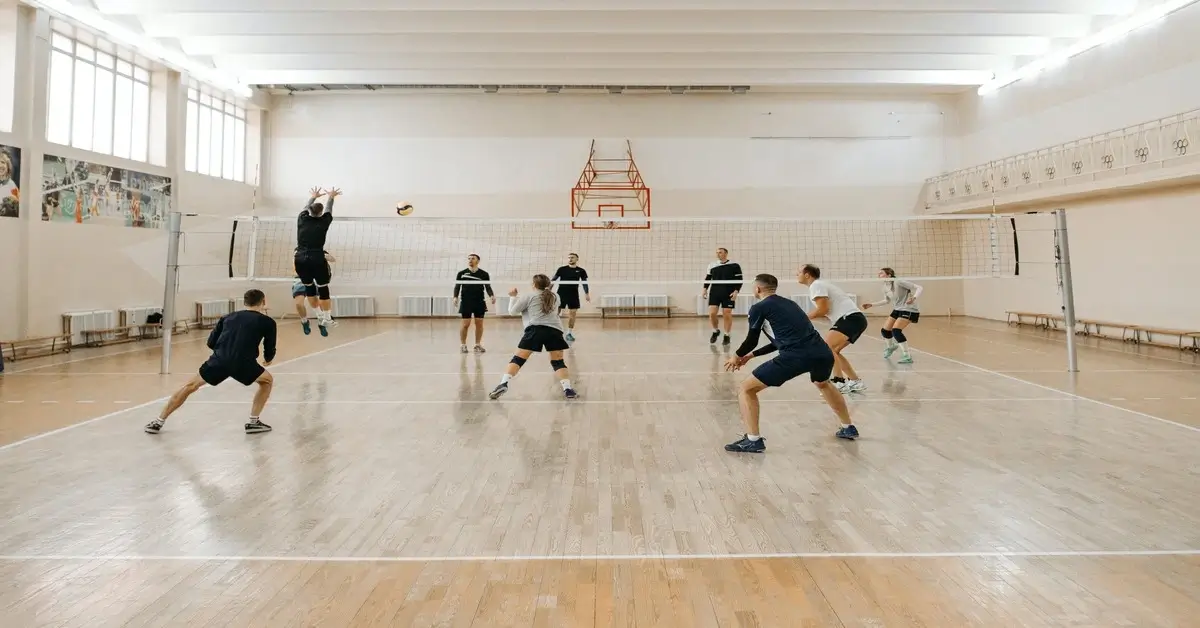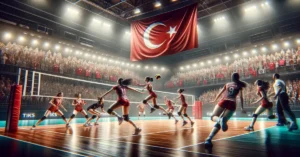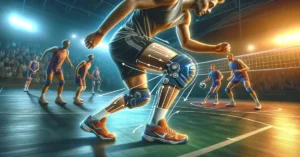It sounds so simple but as active volleyball enthusiasts, we see other players who might not have an understanding of the various positions in the game too often. Knowing where you need to be and what’s expected of you in each position can make the difference between a well-organized team and a group of players just trying to hit the ball over the net.
Let’s dive into answering the question: what are the positions in volleyball? In this fast-paced and exciting sport, knowing each player’s role and position can greatly impact a team’s performance and overall strategy.
What are the positions in Volleyball?
There are six key positions in volleyball, each with its own unique set of responsibilities and skills. For fans and players alike, grasping the fundamentals of these positions in volleyball not only helps us appreciate the complexities of the game but also elevates our enjoyment and love for the sport.
A setter is often compared to the quarterback in American football. They touch the ball more than anyone else and make split-second decisions that can win or lose points. They are responsible for distributing the ball to the attackers, deciding which teammate gets the opportunity to score. A good setter must possess exceptional decision-making skills and quick reflexes.

Outside hitters are among the most versatile players on the court. Positioned on the left side of the court, they often receive the first attack, requiring them to be skilled in both offensive and defensive aspects. Their main weapon is a powerful spike, but they must also master passing and blocking.

The opposite position is similar to that of the outside hitter, but these players are situated on the right side of the court. They are primarily responsible for balancing out the attack, providing back-row defense, and blocking against the opposing team’s outside hitters.
Middle blockers are responsible for blocking the opponents’ attacks and initiating a team’s offensive plays. As such, they need excellent timing and anticipation, as well as the ability to read the game. Quick reflexes and good jumping ability are crucial for this position.

The libero is a defensive specialist who plays an essential role in the back row. They excel in skills such as digging and passing, contributing immensely to the team’s overall defense and ball control. The libero wears a contrasting jersey to help differentiate them from the other players on the court.
The right-side hitters, also known as utility hitters are well-rounded players who can contribute in multiple ways, including offense, defense, and serving. Their adaptability allows them to fill different roles, making them a valuable asset to any team.
Understanding the Volleyball Court
In this section, we will link the question what are the positions in volleyball to how they relate to the court itself. The volleyball court is divided into two main areas: the front court and the back court. Each area has specific roles and responsibilities for the players positioned there.

The front court consists of positions two, three, and four. These positions in volleyball primarily focus on blocking, attacking, and setting. The front court players often work together to create scoring opportunities and prevent the opposing team from getting points.
The back court consists of positions one, five, and six. These positions in volleyball focus on defense, serve receive, and digging. The back court players play a vital role in keeping the ball in play and allowing their teammates to set up for a potential attack.
The positions in volleyball court are numbered one through six. Knowing these numbers and the corresponding positions can help players understand better where they need to be on the court and how they’re expected to contribute to the team’s efforts.
Skills Required for Positions
So it’s not only about the question what are the positions in volleyball. It’s also about understanding the responsibilities and skills, the players need to have in order to fulfill the regarding position on court.
Setter
Technical Skills
- Ball Handling: Superior skills in setting with precision and consistency. This includes delivering accurate sets to various hitters, adjusting to different passing qualities, and minimizing ball-handling errors.
- Serve Receive and Defense: Proficiency in handling first contacts, particularly when the libero is unavailable, and contributing to team defense.
- Dumping and Attacking: Ability to surprise the opponent with setter dumps or attacks, especially when the set options are limited.
Tactical Skills
- Game Management: Expertise in decision-making, including choosing the right attacker for each situation and managing the tempo of the game.
- Opponent Analysis: Skill in reading the opponent’s defense and blockers to exploit their weaknesses and adjust strategies accordingly.
- Team Coordination: Leading and coordinating team play, ensuring all players are aware of the game plan and adjustments.
Physical Attributes
- Agility and Speed: Quickness in moving around the court to reach off-target passes and defensively contribute.
- Endurance: High level of physical stamina to maintain performance throughout the match, given the high frequency of involvement in plays.
- Upper Body Strength: Enough strength to deliver strong, precise sets from all areas of the court.
Outside Hitter
Technical Skills
- Attacking: Strong spiking skills with the ability to hit various shots and angles.
- Serve Receive and Passing: Consistency in passing, essential for establishing effective offensive opportunities.
- Blocking: Competent blocking skills, especially against the opposing team’s opposite hitter.
Tactical Skills
- Adaptability: Ability to adjust hitting strategy based on the set quality and opposing block.
- Defensive Positioning: Understanding defensive schemes and positioning to contribute effectively in backcourt defense.
- Serve Placement: Skill in serving strategically to create difficulties for the opponent’s offense.
Physical Attributes
- Vertical Jump and Power: High vertical leap and power for effective attacking and blocking.
- Stamina: Endurance to maintain high performance levels throughout the game, as they are involved in most plays.
- Speed and Agility: Quickness in transition between offense and defense and in moving around the court.
Opposite Hitter
Technical Skills
- Powerful Hitting: Strong spiking abilities from both front and back row, with a focus on power and precision.
- Blocking: Solid blocking technique, particularly against the opponent’s primary attackers.
- Serving: Proficiency in serving, often aiming for aces or putting the opponent’s passers under pressure.
Tactical Skills
- Strategic Hitting: Ability to read the block and defense to exploit their weaknesses, adjusting hitting angles and power accordingly.
- Back-Row Attack: Understanding when and how to be effective in back-row attacks, especially when front-row options are limited.
- Defensive Adaptability: Versatility in playing defense, both at the net and in the back row.
Physical Attributes
- Height and Power: Taller stature for effective blocking and hitting with significant power.
- Athleticism: General athleticism for all-around play, including agility for defense and strength for powerful hits and serves.
- Endurance: Stamina to maintain performance level, as they are often involved in both offensive and defensive plays.
Middle Blocker
Technical Skills
- Blocking Technique: Mastery in hand positioning, timing, and footwork for effective blocking. This includes the ability to quickly set up a block against fast attacks and adapt to different hitters’ styles.
- Quick Attacks: Proficiency in executing quick and precise attacks, like quick sets or slides, requiring fast arm swings and excellent coordination with the setter.
- Transition Skills: Capability to swiftly transition from blocking to attacking, maintaining a high level of play even during fast-paced exchanges.
Tactical Skills
- Reading the Offense: Expertise in reading the setter’s movements and predicting the play, which is crucial for timely and effective blocking.
- Defensive Strategy: Understanding the team’s defensive system, knowing how to work in tandem with other blockers, and adjusting blocking strategy based on the opponents’ offensive patterns.
- Offensive Contributions: Knowing when to commit to an attack, choosing the right moments to be aggressive at the net, and understanding how to exploit gaps in the opponent’s defense.
Physical Attributes
- Height and Reach: Significant height advantage is beneficial, enabling the player to reach higher over the net, which is crucial for both blocking and attacking.
- Jumping Ability: Exceptional vertical leap is essential to dominate at the net, allowing for more effective blocks and quicker attacks.
- Agility and Speed: Quick lateral movements for effective blocking across the net and the agility to transition rapidly between offense and defense.
Libero / Defensive Specialist
Technical Skills
- Exceptional Passing: Mastery in serve receive and passing, often taking responsibility for a significant portion of the court.
- Digging: Proficiency in digging hard-driven balls, showcasing quick reflexes and precise ball control.
- Ball Control: Ability to control the ball under pressure, setting up the team for counterattacks.
Tactical Skills
- Defensive Strategy: Deep understanding of defensive formations and player positioning to optimize team defense.
- Reading Hitters: Skill in anticipating and reacting to spikers’ tendencies and shot selections.
- Serve Receive Formations: Expertise in organizing serve receive formations and making split-second adjustments.
Physical Attributes
- Agility and Quickness: Exceptional speed and agility to cover large areas of the court.
- Reflexes: Quick reflexes for digging and passing high-velocity spikes.
- Stamina: High endurance to maintain performance level throughout the match, given the high volume of defensive plays.

Right Side Hitter
Technical Skills
- Versatile Hitting: Competence in attacking from both front and back rows, adapting hitting style based on the set and block.
- Blocking: Effective blocking skills, particularly against the opponent’s outside hitters.
- Serving: Strong serving abilities, often aimed at creating offensive opportunities for the team.
Tactical Skills
- Adaptability: Flexibility to adjust roles and responsibilities based on the team’s needs, shifting between offensive and defensive duties seamlessly.
- Strategic Awareness: Understanding of the overall game strategy, including when to attack aggressively and when to play more conservatively.
- Defensive Contributions: Ability to contribute effectively in the back row, both in serve receive and defensive plays.
Physical Attributes
- Athleticism: General athleticism needed for a well-rounded skill set, capable of performing various tasks on the court.
- Power and Precision: Combination of power for hitting and blocking, and precision for serving and defending.
- Stamina and Agility: Good endurance for sustained performance and agility for effective movement in both front and back rows.
Player Rotation and Positioning
Anyone, who has ever played volleyball in a team, knows how important the rotation and positioning is, but also how tricky it can be. Believe us, if we say that those basics are the crucial part of understanding this sport. The reason is that anything related to tactics and system is based on these fundamentals.
We believe that you want to dive deeper into Rotation in Volleyball, so please check out our Blog Post about this challenging and important topic. If you want to get an expert in understanding the positions in volleyball you will also have to understand the rotation systems behind the game.
FAQ
What is position 6 in Volleyball?
Position 6 in volleyball is typically occupied by the libero. This player is a defensive specialist responsible for receiving serves, digging, and covering the backcourt area. The libero wears a contrasting jersey to the rest of the team and has unique rotation rules to enhance the team’s defensive capabilities.
How many Positions are there in Volleyball?
There are a total of six positions on the court in volleyball, with each position covering a specific area and role.
1. Setter
2. Outside Hitter
3. Middle Blocker
4. Opposite Hitter
5. Defensive Specialist
6. Libero
Moreover, there can also be a seventh position called the serving specialist, though this occurs in exceptional circumstances.
What does S stand for in Volleyball?
In volleyball, the letter “S” stands for Setter. The setter is a crucial position responsible for organizing attacks and distributing the ball to the team’s hitters. This player needs to have excellent ball control, awareness, and quick decision-making skills to effectively lead the team’s offensive strategy.
We hope that you liked this blog-post about What are the positions in volleyball. We would be curious what your favourite position in volleyball is. Do you have a favourite one or you don’t mind playing on each position? Let us know in the comments below.






